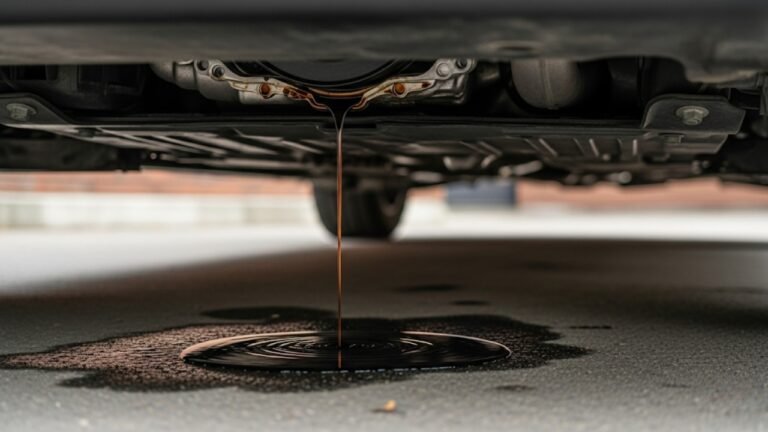How to Know When to Change Car Oil

We’ve all had that moment. You’re sitting at a red light, glancing at the little sticker on your windshield that says, “Oil Change Due.” You squint, do some quick math in your head, and wonder: Do I really need to change it now? If that’s you—don’t worry, you’re not alone. Figuring out how to know when to change car oil can feel like one of those mysterious car things no one really talks about until it’s too late. But trust me, it’s way easier than it sounds.
Oil is basically your engine’s blood. Without it, your car doesn’t stand a chance. I’ve learned this the hard way. A few years ago, I ignored the signs—my engine started making weird ticking noises. It wasn’t long before the mechanic gave me that look. You know, the “this-is-going-to-cost-you” look. All because I skipped an oil change.
So let’s talk. Real talk. No jargon, no lectures. Just the truth about when you really need to change your car’s oil—and how to actually tell.
In This Article
- 1 Your Dashboard Might Be Screaming at You—Listen
- 2 You Can Smell Trouble—Literally
- 3 You Hear Strange Noises—Don’t Turn Up the Radio
- 4 Your Oil Looks Like Coffee Instead of Honey
- 5 You’ve Driven More Than Your Manual Says You Should
- 6 Your Fuel Economy Has Dropped for No Reason
- 7 Seasonal Changes Can Mess with Your Oil More Than You Think
- 8 Your Car Feels Rougher Than Usual—Trust Your Senses
- 9 You’ve Been Driving in Tough Conditions
- 10 Your Oil Change Interval Isn’t One-Size-Fits-All
- 11 Know the Difference Between Oil Types—It Matters
- 12 How to Extend Oil Life Without Risking Damage
- 13 Final Thoughts: Oil Changes Are Self-Care for Your Car
Your Dashboard Might Be Screaming at You—Listen

When you see the oil light flicker or stay on, that’s your cue to act fast. It might mean your oil level is low or the oil pressure is off. Either way, it’s your car saying, “Hey, I need attention!” Don’t brush it off.
Here’s what to look for:
-
Oil pressure warning light (usually looks like an old-school oil can)
-
Check engine light when accompanied by engine noise
-
Sudden drops in performance
Ignoring the dashboard signs is like ignoring a text from your mom when she’s calling twice. Something’s probably up.
Why it matters: The oil light isn’t just a suggestion. Driving with low or dirty oil can wear down your engine parts fast—leading to a total breakdown.
You Can Smell Trouble—Literally
Smells can say a lot about your car’s health. That burnt, nasty odor you sometimes catch when driving? That could be your engine oil breaking down.
Fresh oil smells clean. But when it’s dirty or too old, it starts to cook. And I mean really cook. This burnt smell isn’t just annoying—it’s a warning sign. If you ever catch a scent like burnt toast or something metallic, you should pop the hood.
Common smells that mean it’s oil change time:
-
Burnt oil smell when idling
-
Exhaust fumes inside the cabin
-
Overheated engine smell
Pro tip: If you’re driving and it smells like something’s frying—but there’s no fast food in sight—it’s probably your oil crying for help.
This is one of those gut feeling moments. When in doubt, trust your nose.
You Hear Strange Noises—Don’t Turn Up the Radio
We’ve all done it—heard a noise from the engine and turned up the radio to ignore it. But strange engine sounds, especially clicking or knocking, can be your car begging for fresh oil.
Oil keeps all those metal parts moving smoothly. When it breaks down or runs low, metal starts grinding on metal. That’s when you hear that awful ticking sound when you start the car or rev the engine.
Noises to watch out for:
-
Ticking or tapping during startup
-
Louder engine sounds than usual
-
Grinding or knocking when accelerating
Think of oil as a pillow between your engine parts. Without that cushion, every movement becomes rough, loud, and damaging.
You don’t need to be a mechanic to know something’s off. If your engine suddenly sounds like a washing machine full of bricks, it’s time to check that oil.
Your Oil Looks Like Coffee Instead of Honey
You can learn a lot by just checking your dipstick. Pop the hood, pull it out, wipe it clean, dip it back in, and check the color and level. It’s a super quick and easy habit that tells you almost everything about your oil’s condition.
Fresh engine oil is amber or golden, almost like honey. But old oil turns dark brown or black, sometimes with a gritty texture. That’s a sign it’s picked up dirt, debris, and combustion waste—and it’s not doing its job anymore.
Quick Oil Check Table
| Oil Color | Texture | What It Means |
|---|---|---|
| Golden/Amber | Smooth | Fresh oil, no change needed yet |
| Dark Brown | Slightly Gritty | Approaching time for change |
| Black/Thick | Gritty | Immediate oil change needed |
| Milky/Cloudy | Frothy | Possible coolant leak—see a mechanic |
Keep this in mind: If it looks like coffee sludge, don’t wait. Even if you just got an oil change a few months ago, dirty oil can signal deeper issues.
Doing this simple dipstick check once a month can save you thousands in engine repairs.
You’ve Driven More Than Your Manual Says You Should
Every car is different. Your friend’s Toyota might go 10,000 km before needing an oil change, while your older Honda might need it every 5,000. That’s why checking your owner’s manual matters more than people think.
I used to go by the sticker the shop gave me, but I realized that wasn’t always accurate. Your driving habits, climate, and even how often you’re stuck in traffic all play a role.
Mileage Guidelines by Oil Type:
-
Conventional Oil: Change every 5,000–7,000 km
-
Synthetic Blend: Change every 7,500–10,000 km
-
Full Synthetic Oil: Change every 10,000–15,000 km
Tip: Keep a log. Write down the date and mileage after every oil change. It’s like a diary for your car.
When you go beyond the limit, oil starts to lose its ability to lubricate and clean. That means more wear, more friction, and a greater risk of engine damage.
Your Fuel Economy Has Dropped for No Reason
If you’ve noticed your car’s mileage tanking lately, it could be your oil. Dirty oil creates more drag inside the engine, making it work harder and burn more fuel.
I used to think I just needed to inflate my tires or check the air filter. But it turned out the real issue was old oil. After a fresh change, my fuel economy improved almost instantly.
Signs your oil may be affecting MPG:
-
Fewer kilometers per tank
-
Sluggish acceleration
-
Rough idling or hesitation
It’s like trying to run in sticky boots. When the oil’s thick and dirty, your engine can’t glide—it has to fight for every turn. That effort shows up at the pump.
Seasonal Changes Can Mess with Your Oil More Than You Think
If you live somewhere that has real seasons—scorching summers and bone-chilling winters—you’ve got to factor that into your oil game. Oil behaves differently depending on the temperature. In the cold, it thickens up like old syrup. In the heat, it thins out and breaks down faster.
A few winters ago, I thought I could stretch my oil change just a bit longer. But come January, my car started with hesitation and coughed like it had the flu. Turns out, the oil had turned to sludge overnight. I learned my lesson.
How weather affects oil:
-
Cold weather = thick oil, slow flow, poor startup
-
Hot weather = thinner oil, faster breakdown
-
Humidity or dust = oil contamination risks increase
If you’re in a region with extreme temps, it’s smart to change your oil just before the season shifts. That way, your car is ready for what’s coming, not what just passed.
Your Car Feels Rougher Than Usual—Trust Your Senses
Sometimes, it’s not a smell, a sound, or a dashboard light. It’s just a feeling. That sense when something’s off, even if you can’t put your finger on it.
Maybe the car vibrates more at idle. Or it doesn’t glide through gears as smoothly. These subtle changes in how your car feels can point to old oil that’s lost its magic.
I remember driving back from a weekend trip and noticing my car felt heavy—like it was dragging a suitcase. I didn’t hear anything weird or see any lights. But I followed that gut feeling and checked the oil. It was black, gritty, and way overdue. One oil change later, and it was back to being buttery smooth.
Feelings that shouldn’t be ignored:
-
Shaky idling
-
Slower acceleration
-
Jerky gear changes
-
General sluggishness
Your car talks—just not with words. Learn to listen.
You’ve Been Driving in Tough Conditions
Even if you haven’t hit your mileage target yet, certain driving conditions can accelerate oil wear. Stop-and-go traffic, short trips, towing, dusty roads, and hilly terrain can all take a toll on your engine oil.
Here in the city, stoplights every block are the norm. That means my car never really gets a chance to settle into a smooth cruise. Engines love consistency, and when that’s disrupted, oil wears down faster.
Hard driving habits that demand more frequent oil changes:
-
Frequent short trips under 10 minutes
-
Driving in heavy traffic daily
-
Carrying heavy loads or towing
-
Driving on dusty or gravel roads
-
Repeated hard acceleration or braking
In these cases, even synthetic oil won’t last as long as it should. If your lifestyle fits this picture, you’ll want to change oil more often—even if the odometer says otherwise.
Your Oil Change Interval Isn’t One-Size-Fits-All
Let’s get real. No universal rule tells you exactly when to change your oil. There are too many variables: oil type, car model, climate, driving habits, age of the vehicle—you name it.
Relying on the sticker from your last oil change place? It’s helpful, but not gospel. Trusting your friend’s advice because their car is “just like yours”? Still not enough. What works for them might not work for you.
So, how do you really figure out how to know when to change car oil?
Build Your Own Oil Change Rhythm
-
Track your mileage and dates
-
Listen to your engine sounds and smells
-
Check your oil level and color monthly
-
Adjust based on weather and road conditions
-
Don’t wait for the “perfect” sign
Personal tip: I use a small notebook in my glove box to jot down every oil change, including mileage, brand, and type of oil. It’s old-school, but it works.
Know the Difference Between Oil Types—It Matters
The kind of oil your car uses changes everything. Conventional, synthetic, and synthetic blends each have different lifespans and tolerances.
I once switched from conventional to full synthetic, and wow—the difference in performance was night and day. Quieter engine, smoother start in the winter, and I could go way longer between changes without worry.
Oil Type Comparison Table
| Oil Type | Average Lifespan | Best For |
|---|---|---|
| Conventional | 5,000–7,000 km | Older cars, basic commuting |
| Synthetic Blend | 7,500–10,000 km | Mixed driving, mild climates |
| Full Synthetic | 10,000–15,000 km | High-performance cars, tough conditions |
Knowing what type your car needs and how it performs in your environment is a game-changer. Don’t skimp here—it’s worth investing in the right oil.
How to Extend Oil Life Without Risking Damage
Want to go longer between oil changes? You can—but you need to be smart about it. It’s not just about pouring better oil into your engine. It’s about giving your car the best environment to thrive.
Ways to help your oil last longer:
-
Use high-quality synthetic oil
-
Replace your oil filter with every change
-
Drive smoothly—avoid hard stops and starts
-
Keep tires inflated and engine tuned
Think of it like skincare. The better your daily habits, the less you need to rely on emergency fixes. A well-loved engine treats oil like a partner, not a punching bag.
Final Thoughts: Oil Changes Are Self-Care for Your Car
At the end of the day, how to know when to change car oil is really about building a relationship with your car. Not in a weird way—but in a way that says, “I respect you, and I want you to stick around.”
I’ve had the same car for nearly 10 years now. People ask me how it still runs so smoothly. I tell them, “It’s all about listening and showing up for the basics.” Oil changes may not be glamorous, but they’re the heartbeat of your car’s health.
If you remember nothing else from this guide, remember this:
Oil is the one thing that touches every moving part of your engine. Treat it right, and your car will return the favor.






